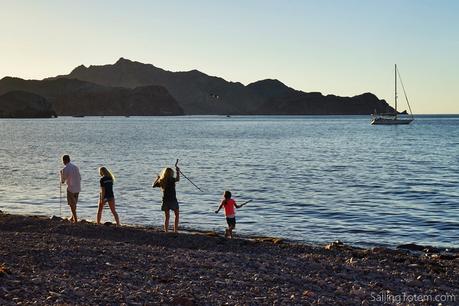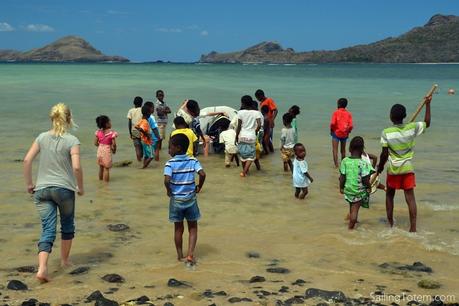
Swing a cat in an anchorage and you’ll hit a boat with an active online presence. When we were in the planning phase of our cruising adventures (the early 2000s), blogging was nascent; only a few recorded their travels. Hungry for information and inspiration, I hung on every word and saved posts for reference; it helped keep the dream alive for years. Now there aren’t just blogs, but a range of social media outlets. What to do? How to decide? I chatted with a couple of our coaching clients about what they do for a broader perspective. Erin is boat mama to three boys, her family cruising the Caribbean since February; JD and Jen have built their family life around living aboard in San Francisco.

Erin & Dave from Sailing to Roam, on the bow of their boat in St Lucia
Connect with your motivation
This blog began in July 2007, a few months after we bought Totem. I sought to capture memories of our family’s transition to life afloat and to keep our family updated after we left: motivations widely shared among cruisers. It’s evolved over time in terms of motivation and channels; now Totem’s blog/ Facebook / instagram indirectly supports our family as a part of the puzzle for our coaching and Jamie’s work as a sailmaker, and I have the privilege to help inspire others in to live more adventurously by sharing our experiences.

JD, Jen, and Ruby of Tight Little Tribe
For Erin, for JD & Jen, the options were greater when they started (YouTube! Instagram! Facebook! Pinterest! More!) but their motivations are similar. Erin wanted to share their adventures with others and started a blog but “found myself wishing the blog was on Facebook, so that’s what I’ve tried to create, a Facebook page with mini blog posts for busy people.” It’s great, bite-sized information mirrored on her Instagram. Jen and JD came from slightly different places: Jen, blogging helped retain details of their baby girl Ruby’s alternative life afloat. JD, on the other hand, has told stories through video. “From a young age back in Kentucky my friends and I would write scripts, plan scenes, grab the camcorder and make ridiculously cliché 80’s style movies and music videos.” Together, they share a joyful look at life on the water.
What we all share? This form of content creation brings benefits, so that the effort we put in is a fair exchange for our time.
Choosing channels

The cruising blog is still around (hello, reader!) but more work and slower growth. Erin put it this way: “I’d also spoken to several people who had a successful blog (in terms of followers and website visits) but also said it was a lot of work for minimal monetary return.” I can attest to that! For me, it’s an outlet with more complicated rewards: a way to process feelings and hindsight perspective on experiences, a way to connect with and support others.
At the far end of the spectrum of effort-per-upload is YouTube. JD shared that he typically spent around 30 hours per video while making a series of videos that ranged from around 8 to 11 minutes each. That’s about 3 hours of editing per one minute of video – and he has experience with editing! Quality videos don’t make themselves. This is exactly what’s kept us out of the YouTube ring to date.
Twitter and Pinterest deserve a mention as part of the mix for Totem, although neither channel is particularly well fed/watered. But they’re useful as traffic drivers, and I appreciate there are some who only engage with us that way. Low effort for engagement return makes maintaining a presence worthwhile.
Key benefits
We all share similar goals to record our experiences in a kind of digital scrapbook, for ourselves and others. Community engagement is also echoed by many families. Per Jen, “I love feeling like I am part of something bigger, with a group of amazing human beings each working towards adventurous goals.”
Erin points out that they’ve been able to meet other families nearby because she keeps their social media presence current. I believe that making yourself findable is really important for cruising families, to help kid boats connect with each other. REALLY important! The point of Happy Boat Kids, Happy Boat is to provide ideas on why/how to do this.
Sharing our lives has grown a circle of friends in meaningful ways: some I get to meet eventually, many I’ve yet to meet but fill an important role. It’s why I’m knitting stripes to send my friend Amanda for her daughter Brie’s blanket, a community project making a rainbow-striped blanket by many hands, all reaching to comfort Brie when she needs heart surgery in September. (See #briesblanket)

Sailing community and knitting. Really.
Erin has also garnered a number sponsors: it’s not income per se but has enabled her family to add some nice kit while waving money. She points out this comes with the responsibility to keep brands happy with what she posts, adds some work, and of course, succeeds when you have an honest voice instead of a pitch.
Some hope to generate income. It’s possible, but this is a long road through a crowded space that demands a lot of work and is probably going to net you less than selling doodles of stick figures on Fiverr. Few are successful, but those that are like our (awesome, earned it, work hard for it) friends on SV Delos have a combination of success factors that are hard to replicate.
Going remote
Many cruising grounds are in cell tower range and connectivity isn’t a problem. But for those going more remote (relying on satellite or radio), it’s more complicated.
Blogs and twitter are the easiest, as they can be readily updated from a simple text email and thus are doable over radio or satellite connection. Data-intensive social media channels are problematic. There are ways to get to Facebook (that’s another post!), but scheduling posts in advance is easier. Scheduled publishing is the option for YouTubers as well, uploading before going remote. Instagram posts can’t be scheduled, at least not without violating T&Cs – not worthile. It requires a phone back in internet-land to post; get a trusted friend involved, or fuhgeddaboudit.
Other ways to mitigate days offline is through connecting channels to repost. A blog posted through our Iridium GO is automatically posted to our Facebook Page, and every post to the Page is re-posted on Twitter. It’s a blunt tool approach to use the channels, very much not optimal, but better than nothing when data is limited. IFTTT (if this then that) recipes are a great way to work out the right daisy chain of reposts.

Comoros: many helpers for dinghy landing, not so many cell towers
Growing a following
At a base level, this isn’t rocket science. Provide quality content people enjoy and want to share; post routinely; engage with others. This organic method is what most do, and in a perfect world it’s all you need and optimize by being active. Wild card exposure to a bigger audience lifts awareness: Erin found an interview with a local paper evolved into a piece in the Daily Mail that gave her an early hit. Totem’s Facebook Page grew by multiples overnight in 2013 after a NY Times columnist mention; this month’s Today show interview didn’t hurt either. Giving interviews for other bloggers or magazines and recording podcasts help find new, relevant followers too. And then, there are those who leverage the boob effect. Good on ’em, it’s not for us though!
What about paying for a boost? I’ve seen this work with an Instagram Growth Service; effort involved in finding and attracting other instagrammers to follow you is relatively time consuming and data intensive (when you’re sipping data like a cruiser!). While that may offer a jumpstart, on the other hand, I don’t know anyone who has found Facebook boosting to actually work… incremental exposure for no bump in followers. Participating in groups that support each other’s posts in a given channel have the benefit of both community and a boost.
No pressure – really!
In a discussion thread among a couple of dozen boat families, many shared that they simply aren’t interested, or have other priorities, or prefer share differently. Artist, jewelry maker, and boat mama Elise said: “For those that don’t blog, the experiences and memories and stories are just as real and fantastic as those that do. How do you normally process and share? Online? Then do that. Via conversation? Then do that! Art? Do that!” A resounding YES! The explosion in social media has created pressure to engage that shouldn’t exist; there should be no guilt in opting out.

Trading when you don’t share a language: unforgettable whether it was on Facebook or not
I also chatted this morning with a fellow boat mama here in the Pacific Northwest. Beth shares her family’s travels on Facebook and intends to explore video, but recognizes “…keeping a balance of living without a camera is important to me too. Family time is what it’s all about, right?” Jen and JD admitted there are times when JD feels like filming “and I just want to be in the moment without a camera… which can lead to some marital strife when we aren’t on the same page at the same time.” A simple blog post can balloon into hours after arriving at final content and image editing. YouTube is even more extreme: “I can also go on editing binges where I get home from work,” shared JD, “and after Ruby goes to bed, I will edit till the wee hours. This can go on for days on end until I finish a project.” It’s a lot of work, worth a hard look before embarking and taking time away from other aspects of your life.
Privacy
Jen commented that she didn’t want to have Ruby ever be upset about her online presence as she gets older, something a lot of parents grapple with. Kids growing up today are test driving the online childhood with outcomes unknown. My friend Charlotte has a fantastic article about why she chose to retire her daughter from her social sharing at age 5 (she admits, an arbitrary number). “If I write about and document every memorable, (and non-memorable) moment of her life, I feel as if I will mute her own interpretation of her childhood.” We want our kids to own their definition of self, and childhood memories, not be captive to how we framed them… we want them to be happy and proud, and they’re the only ones who can really do this. As our kids have grown, I’m able ask their permission to use a particular photo or have them choose from a selection to know it’s one they’d like.
For the most part, this hasn’t been a concern, although there was one afternoon in South Carolina where a series of three unexpected visitors knocked on the hull after seeing our location online. I really love meeting people who are interested in our way of life and it was all good, just a teensy bit unnerving!

Totem crew – early days, a gift of the blogging record to look back and see
Cruising and social media: what works? It’s different and evolving. This blog too may evolve (it at least needs a refresh, any website jockeys around?). We’d love to try video, but life is too full to expand for that effort. What do I wish I could tell my 2007 self? That this little family record would have a wonderful future, and to just stick with it.
With extra big thanks to Erin (Sailing to Roam: blog, insta, facebook) and JD & Jen (Tight Little Tribe: blog, insta, youtube) for their openness and honesty in talking about social media use and goals. Check them out!

